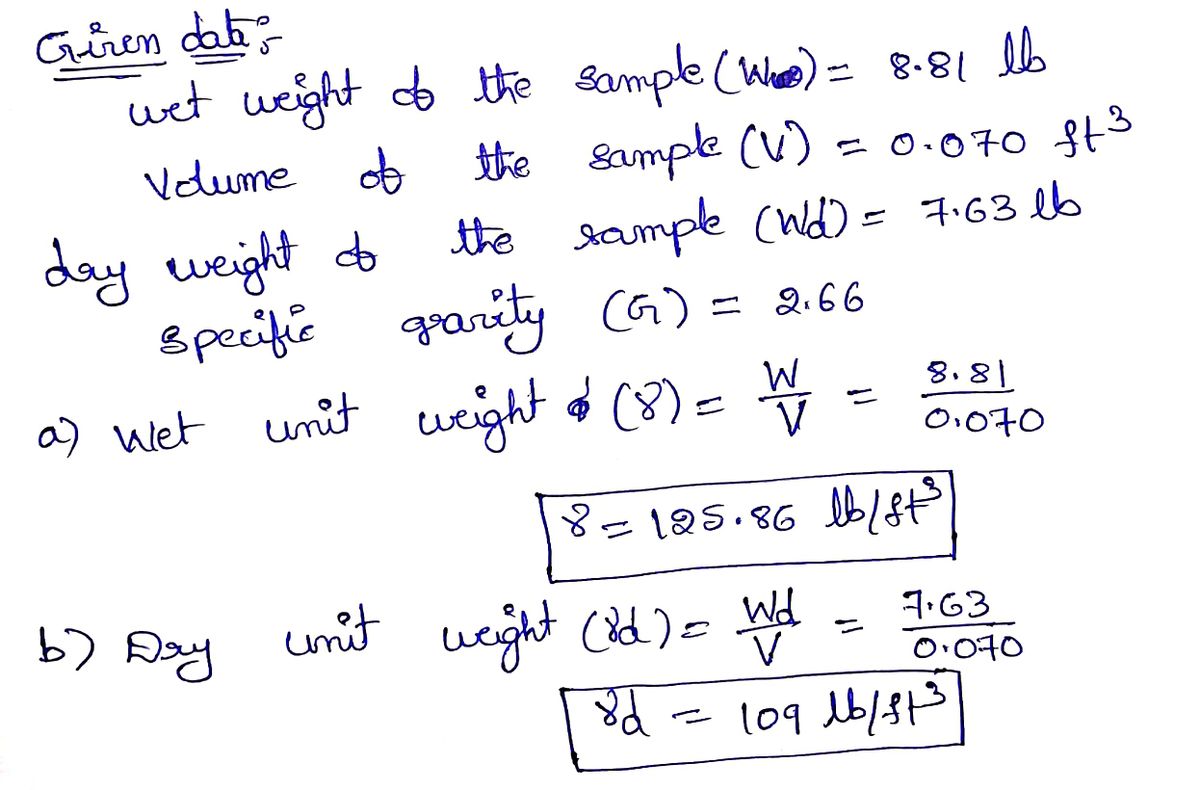
Structural Analysis
6th Edition
ISBN: 9781337630931
Author: KASSIMALI, Aslam.
Publisher: Cengage,
expand_more
expand_more
format_list_bulleted
Concept explainers
Question
A 8.81-pound sample is obtained from an excavation with a volume of 0.070 cubic feet. The sample weight 7.63 pounds after drying. Assume a specific gravity of 2.66. Calculate wet unit weight, dry unit weight, void ratio, porosity and degree of saturation.
Expert Solution
arrow_forward
Step 1

Step by stepSolved in 3 steps with 3 images

Knowledge Booster
Learn more about
Need a deep-dive on the concept behind this application? Look no further. Learn more about this topic, civil-engineering and related others by exploring similar questions and additional content below.Similar questions
- The hydraulic conductivity of a soil sample (3.4 x 10-4 cm/s) has been determined via a permeability test. The water temperature was 28°C at the time of experiment. What is the hydraulic conductivity of the sample at the standard temperature of 20°C?arrow_forwardA modified Proctor compaction test was carried out using a cylindrical moldwith a 1000 ml volume. Table 2 summarizes the results.a. Plot the compaction and ZAV curves (RD=2.75 and ρwater=1000 kg/m3).b. Determine the maximum dry density and the optimum moisture content.arrow_forwardA sample of sand is subjected to a constant head permeability test. The sample diameter is 60 mm and its length is 130 mm. Under an applied head of 60 cm, 119 cm³ of water flows through the sample in 5 minutes. Determine (a) the coefficient of permeability, and (b) the discharge velocity.arrow_forward
- The hydraulic conductivity of a sand at a void ratio of 0.71 is 0.044 cm/sec, Estimate the hydraulic conductivity of this sand at a void ratio of 0.55arrow_forwardA modified Proctor compaction test was carried out using a cylindrical moldwith a 1000 ml volume. Table 2 summarizes the results. a. Plot the compaction and ZAV curves (RD=2.75 and ρwater=1000 kg/m3)b. Determine the maximum dry density and the optimum moisture content Table 2 Moisture Content (%)Mass of WetSample (g)10.5 2033.211.8 2146.613.0 2203.514.9 2183.116.4 2147.617.6 2116.8arrow_forward
arrow_back_ios
arrow_forward_ios
Recommended textbooks for you

 Structural Analysis (10th Edition)Civil EngineeringISBN:9780134610672Author:Russell C. HibbelerPublisher:PEARSON
Structural Analysis (10th Edition)Civil EngineeringISBN:9780134610672Author:Russell C. HibbelerPublisher:PEARSON Principles of Foundation Engineering (MindTap Cou...Civil EngineeringISBN:9781337705028Author:Braja M. Das, Nagaratnam SivakuganPublisher:Cengage Learning
Principles of Foundation Engineering (MindTap Cou...Civil EngineeringISBN:9781337705028Author:Braja M. Das, Nagaratnam SivakuganPublisher:Cengage Learning Fundamentals of Structural AnalysisCivil EngineeringISBN:9780073398006Author:Kenneth M. Leet Emeritus, Chia-Ming Uang, Joel LanningPublisher:McGraw-Hill Education
Fundamentals of Structural AnalysisCivil EngineeringISBN:9780073398006Author:Kenneth M. Leet Emeritus, Chia-Ming Uang, Joel LanningPublisher:McGraw-Hill Education
 Traffic and Highway EngineeringCivil EngineeringISBN:9781305156241Author:Garber, Nicholas J.Publisher:Cengage Learning
Traffic and Highway EngineeringCivil EngineeringISBN:9781305156241Author:Garber, Nicholas J.Publisher:Cengage Learning


Structural Analysis (10th Edition)
Civil Engineering
ISBN:9780134610672
Author:Russell C. Hibbeler
Publisher:PEARSON

Principles of Foundation Engineering (MindTap Cou...
Civil Engineering
ISBN:9781337705028
Author:Braja M. Das, Nagaratnam Sivakugan
Publisher:Cengage Learning

Fundamentals of Structural Analysis
Civil Engineering
ISBN:9780073398006
Author:Kenneth M. Leet Emeritus, Chia-Ming Uang, Joel Lanning
Publisher:McGraw-Hill Education


Traffic and Highway Engineering
Civil Engineering
ISBN:9781305156241
Author:Garber, Nicholas J.
Publisher:Cengage Learning